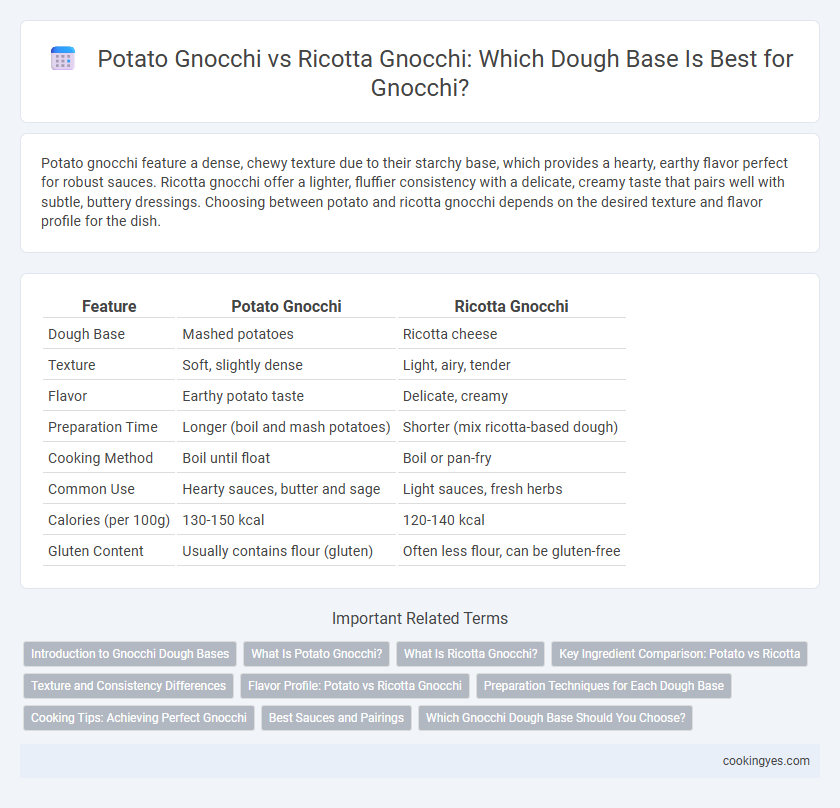Potato gnocchi feature a dense, chewy texture due to their starchy base, which provides a hearty, earthy flavor perfect for robust sauces. Ricotta gnocchi offer a lighter, fluffier consistency with a delicate, creamy taste that pairs well with subtle, buttery dressings. Choosing between potato and ricotta gnocchi depends on the desired texture and flavor profile for the dish.
Table of Comparison
| Feature | Potato Gnocchi | Ricotta Gnocchi |
|---|---|---|
| Dough Base | Mashed potatoes | Ricotta cheese |
| Texture | Soft, slightly dense | Light, airy, tender |
| Flavor | Earthy potato taste | Delicate, creamy |
| Preparation Time | Longer (boil and mash potatoes) | Shorter (mix ricotta-based dough) |
| Cooking Method | Boil until float | Boil or pan-fry |
| Common Use | Hearty sauces, butter and sage | Light sauces, fresh herbs |
| Calories (per 100g) | 130-150 kcal | 120-140 kcal |
| Gluten Content | Usually contains flour (gluten) | Often less flour, can be gluten-free |
Introduction to Gnocchi Dough Bases
Potato gnocchi dough is traditionally made from cooked potatoes, flour, and eggs, creating a dense and chewy texture with a slightly earthy flavor. Ricotta gnocchi dough uses ricotta cheese combined with flour and eggs, resulting in a lighter, softer, and more delicate bite. Both dough bases offer distinct taste and texture profiles, catering to varying culinary preferences and regional Italian traditions.
What Is Potato Gnocchi?
Potato gnocchi are soft, pillowy Italian dumplings made primarily from cooked potatoes, flour, and sometimes egg, creating a tender and slightly chewy dough base. The starchy potatoes provide a delicate texture that holds sauces well, distinguishing them from ricotta gnocchi, which use cheese as the main ingredient for a lighter, creamier consistency. Potato gnocchi's dough base is ideal for hearty, robust dishes due to its density and subtle potato flavor.
What Is Ricotta Gnocchi?
Ricotta gnocchi features a dough base made primarily from ricotta cheese combined with flour, resulting in a lighter and softer texture compared to traditional potato gnocchi, which relies on mashed potatoes for its density and chewiness. This cheese-based alternative offers a delicate flavor and requires less cooking time due to its tender consistency. Ricotta gnocchi is often preferred in recipes that emphasize creamy sauces or fresh herbs, highlighting its subtle, creamy profile.
Key Ingredient Comparison: Potato vs Ricotta
Potato gnocchi use cooked, mashed potatoes as the primary base, providing a dense and chewy texture with a mild, earthy flavor ideal for hearty sauces. Ricotta gnocchi incorporate ricotta cheese, resulting in a lighter, softer dough with a creamy taste and more delicate mouthfeel. The choice between potato and ricotta significantly affects the dough's moisture content, gluten development, and overall tenderness, influencing cooking methods and paired sauces.
Texture and Consistency Differences
Potato gnocchi have a denser and chewier texture due to the starchy potatoes in the dough, giving them a firm yet tender bite. Ricotta gnocchi are lighter and softer with a creamier consistency, as the ricotta cheese adds moisture and airiness to the dough. The difference in base ingredients results in potato gnocchi retaining shape better during cooking, while ricotta gnocchi offer a more delicate and melt-in-the-mouth experience.
Flavor Profile: Potato vs Ricotta Gnocchi
Potato gnocchi offer a rich, earthy flavor with a slightly dense texture that absorbs sauces well, creating a comforting and hearty bite. Ricotta gnocchi present a lighter, creamier taste with a subtle sweetness and delicate texture, making them ideal for more refined, delicate sauces. Both varieties showcase unique flavors where potato gnocchi emphasize robustness, while ricotta gnocchi highlight softness and mildness.
Preparation Techniques for Each Dough Base
Potato gnocchi dough requires boiling and mashing starchy potatoes, often Russets, before incorporating flour and sometimes egg to achieve a tender, elastic texture. Ricotta gnocchi dough blends ricotta cheese with flour and eggs, resulting in a lighter, creamier dough that demands gentle handling to maintain softness. Both doughs require careful kneading and portioning, but potato gnocchi often needs more flour for structure, while ricotta gnocchi relies on cheese moisture content for richness.
Cooking Tips: Achieving Perfect Gnocchi
Potato gnocchi requires boiling potatoes with the skin on to prevent excess moisture absorption, then ricing them while hot to create a light, tender dough that cooks quickly without falling apart. Ricotta gnocchi dough benefits from minimal handling and the addition of fine semolina or flour to provide structure, resulting in a softer texture that requires gentle boiling for just a few minutes until they float. Using a fork to create ridges on either type ensures sauce adherence and an evenly cooked interior.
Best Sauces and Pairings
Potato gnocchi's tender, pillowy texture pairs exceptionally well with rich, bold sauces like classic marinara, sage browned butter, or creamy gorgonzola, as its starchy base absorbs flavors deeply. Ricotta gnocchi, lighter and more delicate, complements subtle, fresh sauces such as lemon-basil pesto, simple olive oil with garlic, or a gentle tomato cream, highlighting the cheese's creamy softness. Both varieties shine when paired with fresh herbs, Parmesan cheese, and contrasting textures like toasted pine nuts or crispy pancetta for enhanced flavor complexity.
Which Gnocchi Dough Base Should You Choose?
Potato gnocchi features a dough base made primarily from mashed potatoes and flour, offering a soft texture and a slightly earthy flavor, ideal for classic Italian dishes. Ricotta gnocchi uses ricotta cheese combined with flour and eggs, resulting in a lighter, creamier dough that cooks faster and pairs well with delicate sauces. Choosing between potato and ricotta gnocchi depends on desired texture and flavor intensity, with potato gnocchi providing a heartier bite and ricotta gnocchi delivering a tender, airy experience.
Potato gnocchi vs ricotta gnocchi for dough base Infographic

 cookingyes.com
cookingyes.com